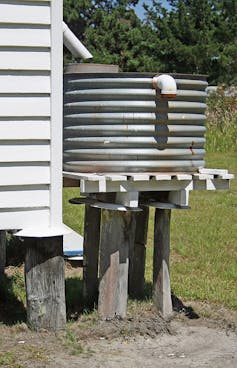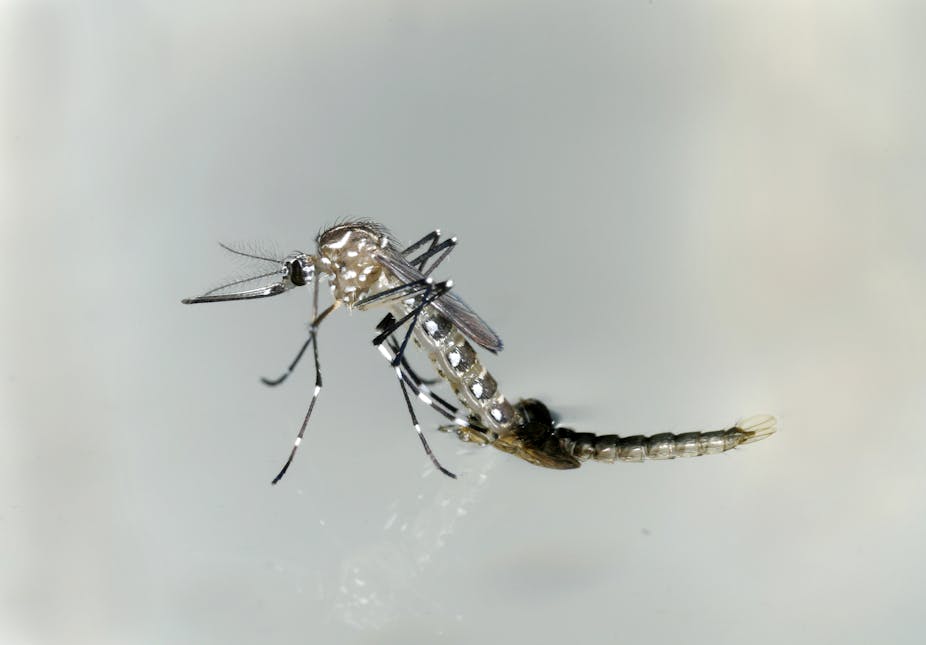Dengue is caused by four different serotypes (strains) of the dengue virus that can cause mild to severe illness in people, who are infected via mosquito bites. Dengue has been spreading through most urbanised areas in the tropics in the last 30 years. Up to 40% of the global population live in dengue-infected tropics, and an estimated 50 to 100 million cases occur annually.
Classical dengue, the most common type of the illness, is characterised by a high fever, splitting headaches, vomiting, a rash and body aches. It’s referred to colloquially as “breakbone fever”. The severe form of the illness, dengue haemorrhagic fever (DHF), is rare and its symptoms include blood plasma leakage, which may lead to shock and, potentially, death.
There’s no vaccine or specific medication to prevent dengue but both types can be treated with early diagnosis and fluid-replacement therapy. While fatalities are rare (less than 1% of cases), dengue epidemics can bring illness to thousands of people within weeks, causing chaos in communities and costing millions of dollars.
Dengue in Australia
The illness was once common in eastern Australia from the late-19th century through mid-20th century, stretching south nearly to Sydney. Large epidemics occurred in eastern New South Wales and Queensland. But with the demise of rainwater tanks after World War II and the advent of piped water, dengue-carrying mosquitoes retreated to north Queensland, where ample rains provide year-round breeding sites.

Dengue is now limited to the urban areas of north Queensland, the only region in Australia that has the carrier Aedes aegypti mosquito. Highly urbanised and feeding almost exclusively on humans, this mosquito loves unscreened old Queensland houses.
And the area is increasingly subject to outbreaks of the illness. Since 2000, there have been 36 dengue outbreaks in north Queensland, resulting in 2,364 confirmed cases that led to three deaths – all this from the bite of a rather innocuous-looking mosquito.
The increase in dengue activity overseas is also responsible for an escalation of imported cases into Australia. In the dengue-receptive cities of Cairns and Townsville, the number of imported dengue cases has jumped from ten a year to between 30 and 50 a year in the last four years. All four dengue types have been active in the area, resulting in multiple outbreaks.
To date, Queensland Health staff based in Cairns and Townsville have been able to eliminate the virus in each of the 40 different outbreaks in the region since 1995, preventing the virus from becoming established (endemic) in north Queensland. This is important as persistent outbreaks of multiple dengue viruses is associated with increased incidence of severe illness and deaths.
Current global dengue trends suggest the virus will become more common in Australia. Rainwater tanks are again decking suburban yards, and outbreaks of the virus have increased overseas (like the current epidemic in India), which means more imported cases of dengue.
Controlling dengue outbreaks
While mosquitoes breed in obvious stagnant water sites such as tyres, buckets, pot plant bases and boats under the mango tree, they also exploit hidden, flooded “cryptic containers” that are even harder to remove or treat. These include sump pits, telecommunication pits, septic tanks, roof gutters and rainwater tanks.

Dengue cases are also hard to isolate, especially the all-important index case (the initial case imported from overseas that kicks off an outbreak). Australia’s love affair with Bali has resulted in hundreds of cases among cash-flushed youth seeking a brief tropical holiday. And the epidemic in India could have a strong impact unless controlled before the end-of-year holidays.
All of Queensland’s recent large outbreaks, from the 500 cases in 2003 to the recent 1,000 cases in 2008-09, were initiated by a traveller who was not detected by the health system for over four weeks. By the time Queensland Health knew about the ignition point for the outbreak, several other people had been infected, and had spread the virus throughout the Cairns area.
Dengue control involves careful synchronisation of a multi-disciplinary team of public health nurses, epidemiologists, entomologists and mosquito control experts, and health promotion workers. Loss of any part of this team can seriously impact the overall success of a control program.
While some control methods in development hold some promise – the Wolbachia bacteria that blocks dengue infection in mosquitoes, for instance, and Sumitomo’s smokeless mosquito coil that repels and kills mosquitoes in the house – they’re still in some years away from becoming available.
Given the increase in dengue activity overseas, the need to support current dengue infrastructure has never been greater.
See more Explainer articles on The Conversation.

